Gaura Plant Care can be rewarding as it can give any wildflower a run for its money. Learn How to Grow Bee Blossom with our guide.
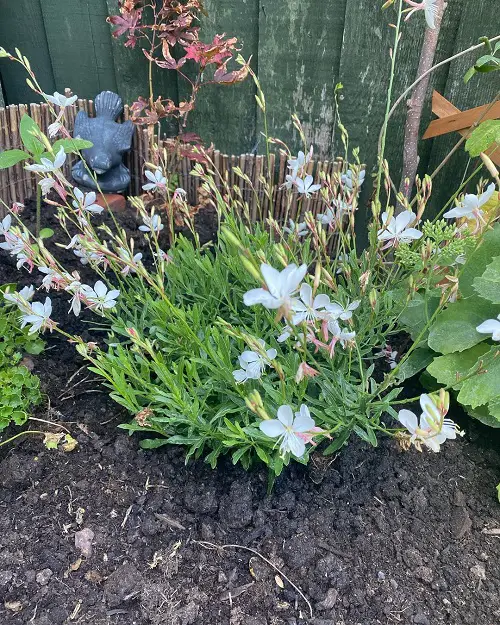
Gaura Plant Care and Growing are easy as this stunning perennial wildflower is low maintenance. Check out How to Grow Gaura to flaunt its beautiful blooms in your garden!
Botanical Name: Oenothera lindheimeri
USDA Zones: 5-9
Common Names: Wandflower, Butterfly gaura, Whirling butterfly, Siskiyou pink
Here is How to Grow Celosia
Gaura Plant Information
The Gaura plant, scientifically known as Oenothera lindheimeri, is a member of the Onagraceae family, commonly referred to as the Evening Primrose family. This native North American plant is predominantly found in regions like Texas and Louisiana.
The Gaura plant possesses a distinctive appearance that distinguishes it from other flowering plants. It boasts long, slender stems that can reach heights of 2 to 4 feet. At the apex of each stem, small, star-shaped flowers bloom, presenting captivating shades of pink, white, or a delightful blend of both. These flowers typically exhibit four petals and an abundance of stamens, enhancing their allure. Complementing the blossoms are lance-shaped leaves that alternate along the stems, adding an elegant touch to the overall aesthetic.
The Gaura plant’s slender stems and lightweight flowers create a captivating visual effect akin to a dance in the breeze. This attribute has earned it the common name “Whirling Butterflies.” Moreover, the Gaura plant showcases an extended blooming period, often commencing in late spring and persisting until fall, ensuring a continuous display of beautiful flowers.
Learn about growing Purslane in containers here
Propagating Gaura Plant

Gaura plants can be propagated through methods such as seeds, stem cuttings, and division. However, the easiest methods for propagating Gaura are through seeds and stem cuttings.
From Seeds:
- Collect mature seeds from existing Gaura plants.
- Prepare a well-draining soil mix suitable for seed germination.
- Sow the Gaura seeds directly into the soil or start them indoors in pots.
- Ensure the soil is consistently moist but not waterlogged.
- Provide the seeds with indirect sunlight and maintain a warm temperature.
- Germination typically takes around 2 to 3 weeks, after which seedlings can be transplanted into the desired location.
Find How Vinegar Improves Seed Germination (Proven by Science) here
From Cuttings:
Propagation by cuttings should be done in spring and late summer.
- Select a healthy stem from an existing Gaura plant.
- Trim the stem to about 4-6 inches in length, just below a node.
- Remove the lower leaves from the stem, leaving only a few at the top.
- Dip the cut end of the stem in a rooting hormone to encourage root development.
- Plant the stem cutting in a pot filled with moist soil or a propagation medium.
- Place the cutting in a location with indirect sunlight and maintain soil moisture.
- After a few weeks, roots should begin to develop, indicating successful propagation.
Usually, it takes about 50-60 days for new growth to start showing. Then, you can transplant the young plants into separate pots of similar size—resume the usual Gaura plant care.
Best Pot for Gaura Plant
To facilitate the optimal growth of Gaura plants, it is important to choose the right pot size. A pot with a diameter of 12 to 16 inches (30 to 40 cm) is generally recommended for growing Gaura. Such a size provides sufficient space for the plant’s root system to spread and allows for proper airflow around the roots.
Opting for a larger pot size helps in Gaura Plant Care and prevents the plant from becoming root-bound, promoting stability. It is essential to ensure that the pot has adequate drainage holes to prevent waterlogging and maintain well-draining soil conditions.
Here are Plant Pot Sizes from Inches to Gallon
Requirements for Growing Gaura
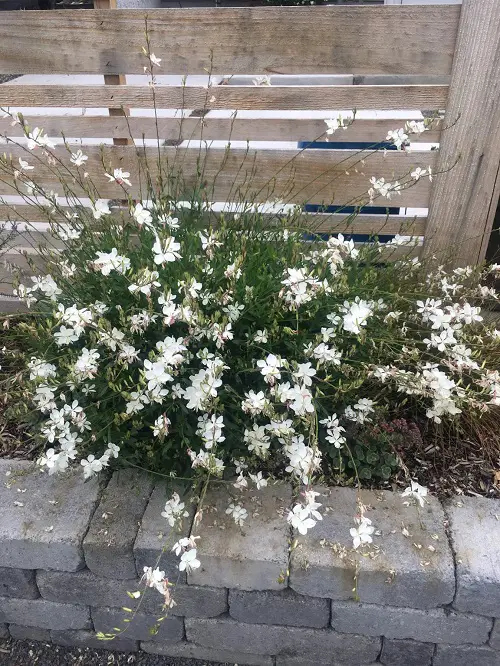
Sunlight
Gaura plants thrive in full sun to partial shade, requiring at least 6 to 8 hours of direct sunlight each day. It is best to choose a location that receives ample sunlight for optimal growth and abundant flowering.
However, they can tolerate some shade, making them versatile for various garden settings.
Soil
Gaura plants prefer well-draining soil that is rich in organic matter. A sandy loam or loamy soil type is ideal for their growth. Ensure the soil has good drainage to prevent waterlogged conditions, which can lead to root rot.
Find out some Helpful Hacks to Improve Your Garden Soil for Free here
Amending the soil with compost or organic matter before planting can help improve its fertility and drainage.
Watering
Gaura plants have moderate water requirements. Water them deeply but infrequently, allowing the topsoil to dry out between watering sessions. Avoid overwatering, as it can lead to root issues.
Here are the best ways to water plants
Regularly check the soil moisture by inserting your finger into the soil to determine if it is dry before watering again.
Temperature and Humidity
Gaura plants are generally tolerant of a wide range of temperatures. They thrive in warm to hot climates and can withstand mild frosts. Ideally, the temperature should be between 65 to 85°F (18 to 29°C) for optimal growth.
Gaura plants can tolerate moderate humidity levels but generally prefer drier conditions.
Gaura Plant Care
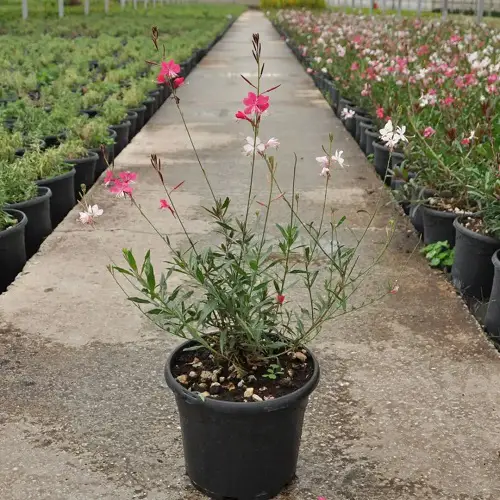
For proper care of Gaura plant, make sure you take care of the following.
Fertilizer
Gaura plants generally do not require heavy fertilization. However, you can apply a balanced, slow-release fertilizer once in early spring to provide them with essential nutrients. Alternatively, incorporating compost or well-rotted manure into the soil during planting can provide a nutrient-rich environment.
Here are the Best Fruit Peels You Can Use as Fertilizers
Avoid excessive use of nitrogen-rich fertilizers, as they can promote excessive foliage growth at the expense of flowering.
Pruning
Gaura plants benefit from periodic pruning to maintain their shape and promote bushier growth. In early spring, before new growth emerges, prune the plants by cutting back the stems to about half their height. This helps to rejuvenate the plant and encourage the development of new branches and flowers.
Additionally, removing spent flowers throughout the blooming season can promote prolonged flowering and prevent self-seeding.
Overwintering
Gaura plants are generally hardy and can withstand mild frosts. In regions with colder winters, providing a layer of organic mulch around the base of the plant in late fall can help protect the roots from freezing temperatures.
However, in areas with severe winters, it is advisable to treat Gaura as an annual or move potted plants indoors to protect them from frost damage. It is also recommended to mulch around the roots to insulate them, especially if you live below USDA Zone 8.
Pests and Diseases
Gaura plants are relatively resistant to pests and diseases. However, they can occasionally be affected by aphids or spider mites. Monitor the plants regularly and take appropriate measures, such as spraying with a mild insecticidal soap or using a strong stream of water to dislodge the pests.
Ensure good air circulation around the plants to prevent fungal diseases such as powdery mildew. If necessary, apply an appropriate fungicide following label instructions.
Types of Gaura
Although there are several cultivated kinds of Gaura that you can pick from, we have made a list of popular ones for you:
1. Corrie’s Gold

The gold in the name is for the gorgeous variegated foliage, not the white blooms with a hint of pink.
2. Passionate Rainbow
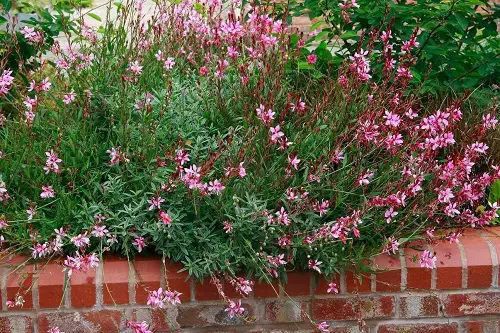
If you grow this type of Gaura, you will be blessed with cute pink flowers and foliage with pink edges.
3. Crimson Butterflies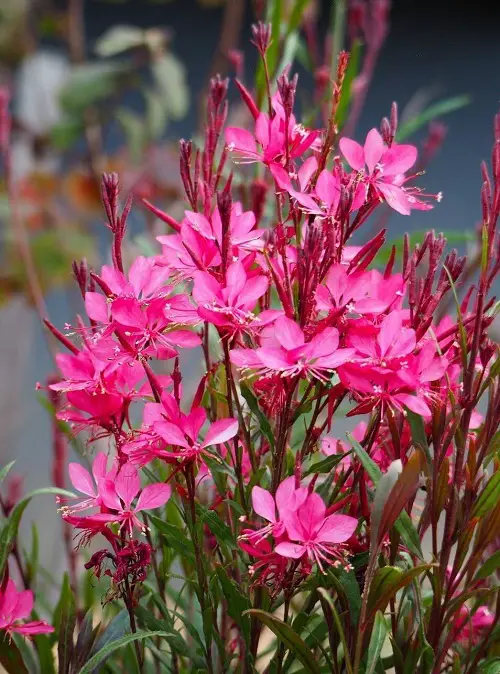
This butterfly plant Gaura boasts burgundy foliage, red stems, and bright pink flowers. You can grow them with green or blue flowers to create an impression.
4. Sparkle White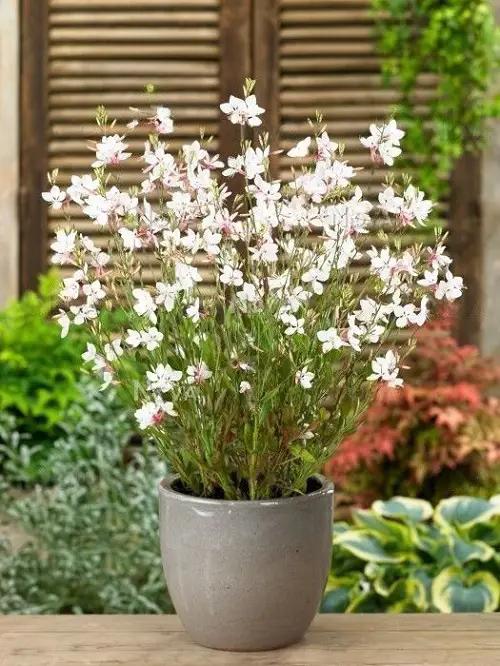
In this pretty white gaura plant, you can have elegant white flowers tinged with pink. For its marvelous performance and beauty, it also received the Fleuroselect Gold Medal in 2014.
5. Siskiyou Pink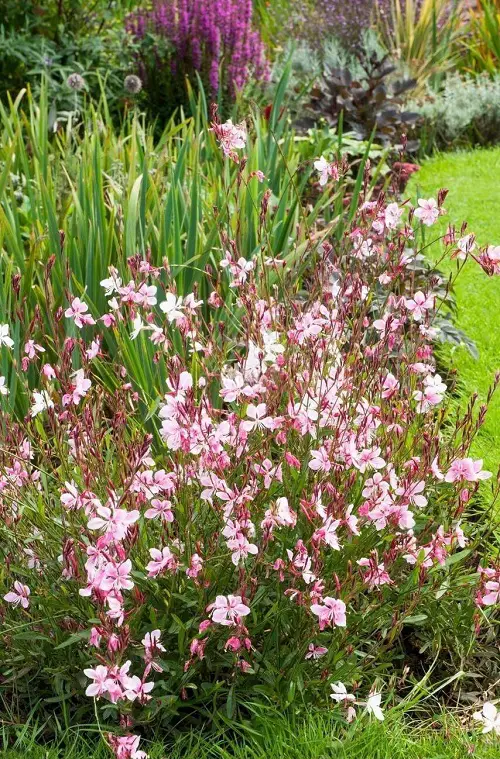
Looking for a beautiful pink Gaura plant? Grow the Siskiyou Pink variety for amazing ornamental blooms in a rose pink shade.
6. Gaura Biennis
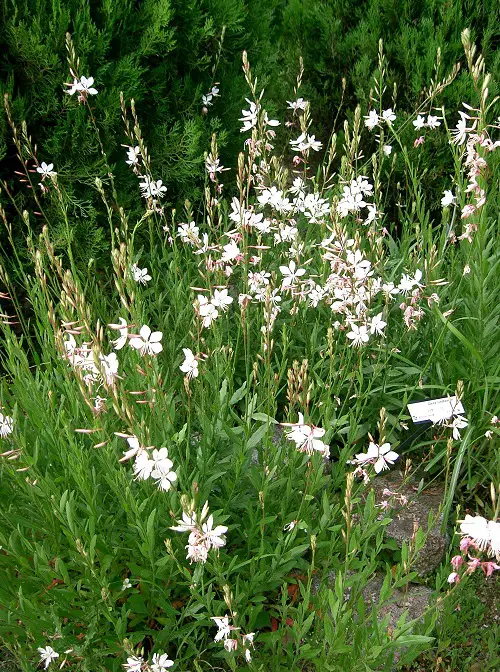
A tall variety that can grow 3-6 feet high. It has hairy flowering stems and light pink or white colored flowers that turn into coral red in late summer and fall.
7. White Gaura

A Texas native, tolerant to drought. It grows up to 3-5 feet tall, and flowers appear from summer to fall.
Quick Gaura Plant Care Tips
- Regularly remove spent flowers by deadheading to promote continuous blooming and prevent self-seeding.
- In cases where Gaura plants have tall and delicate stems that may bend or lean, providing stakes or supports can help keep them upright.
- Gaura plants are fairly drought-tolerant once established. However, during prolonged dry periods, providing supplemental water can help maintain their vigor and prevent wilting.
- Every few years, consider dividing mature Gaura plants to rejuvenate them and prevent overcrowding. This can be done in early spring or fall by carefully separating the root clumps and replanting them.
- Gaura plants can be beneficially paired with other plants in the garden. Gaura companion plants include ornamental grasses, perennial flowers, and native wildflowers, creating beautiful and harmonious plant combinations.




Very interesting article
I saw plant at a nursery in very late summer
Would like to buy seeds next year